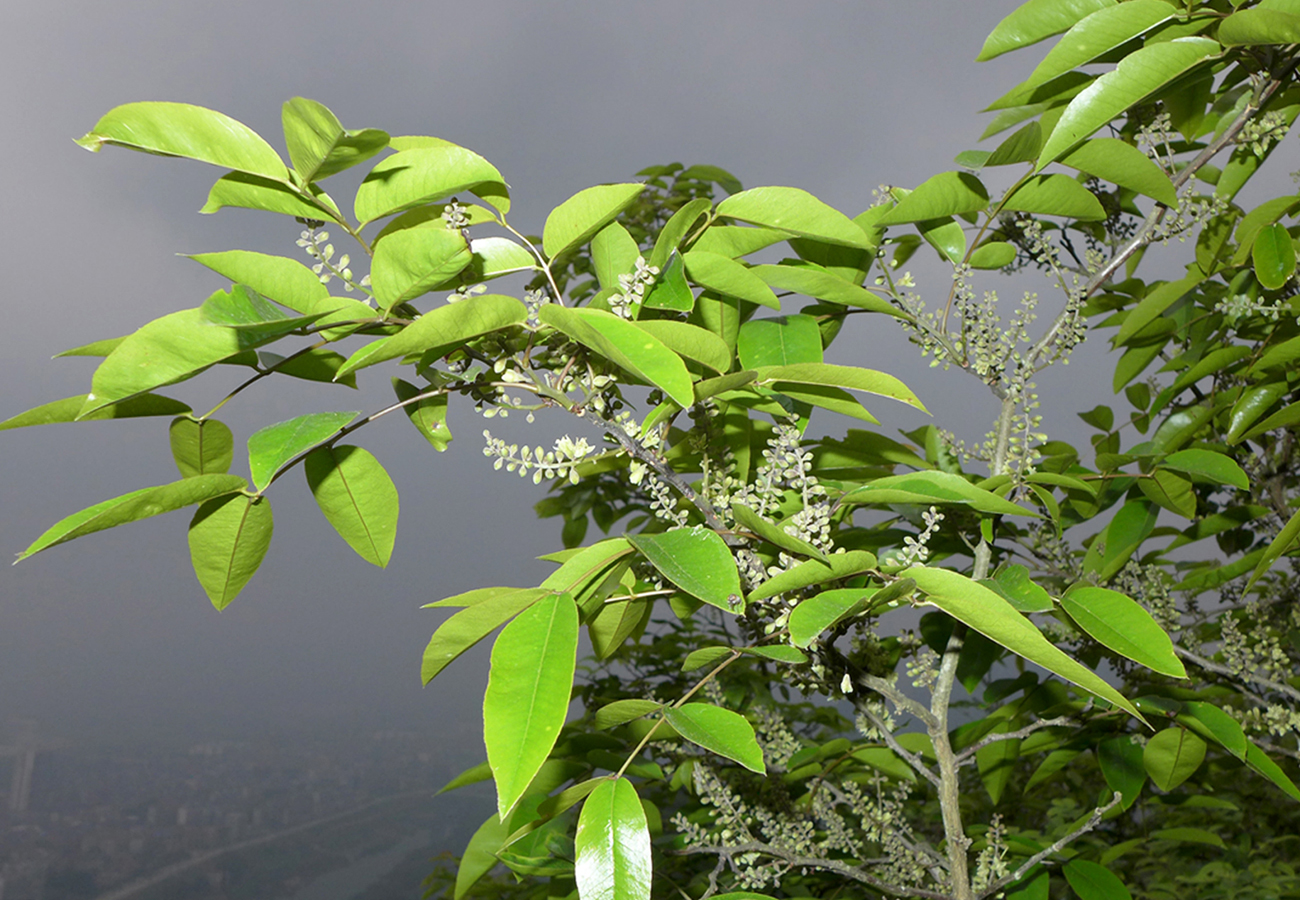Abstract
Gleditsia saxatilis Z.C.Lu, Y.S.Huang & Yan Liu, a new species was found from limestone areas of Guangxi, China. The morphological and phylogenetic analyses showed that G. saxatilis is similar to G. sinensis, but differs by its habit indeciduous, winter buds globose or subglobose, apex round, petiolules glabrescent to glabrous, leaflets 2–4 pairs, leathery, both sides glabrous, racemes shorter, 2.5–7 cm long, ovary glabrous, legume slightly falcate, stipe 3–8 mm long.
References
<p>Baillon, H.E. (1875) <em>Bulletin Mensuel de la Société Linnéenne de Paris.</em> 34 pp.</p>
<p>Chen, D.Z., Zhang, D.X. & Larsen, K. (2010) <em>Gleditsia</em> L. <em>In</em>: Wu, Z.Y., Raven, P.H. & Hong, D.Y. (Eds.) <em>Flora of China</em>, 10. Science Press, Beijing & Missouri Botanical Garden Press, St Louis, pp. 36–39.</p>
<p>Dizaji, E.F., Mohsen, K., Ahmad, K. & Kalateh, J.S. (2016) Phytoremediation of lead and cadmium by thornless honey loccust trees (<em>Gleditsia triacanthos</em> L. subsp. <em>inermis</em>) in contaminated soil near the Tehran-Karaj highway. <em>Indian Journal of Agricultural Research</em> 50 (6): 579–583.</p>
<p>Doyle, J.J. & Doyle, J.L. (1987) A rapid DNA isolation procedure for small quantities of fresh leaf tissue. <em>Phytochemical Bulletin</em> 19: 11–15.</p>
<p>Edgar, R.C. (2004) MUSCLE: multiple sequence alignment with high accuracy and high throughput. <em>Nucleic Acids Research </em>32 (5): 1792–1797.http://do.doi.org/10.1093/nar/gkh340</p>
<p>Fredrik, R., Maxim, T., Paul, V.D.M., Ayres, D.L., Aaron, D. & Sebastian, H. (2012) MrBayes 3.2: Efficient Bayesian Phylogenetic Inference and Model Choice Across a Large Model Space. <em>Systematic Biology </em>61 (3): 539–542. http://do.doi.org/10.1093/sysbio/sys029</p>
<p>Guo, J., Meng, T., Pang, H.B. & Zhang, Q. (2016) <em>Petrocodon retroflexus </em>sp. nov. (Gesneriaceae) from a karst cave in Guizhou, China. <em>Nordic Journal of Botany </em>34 (2): 159–164.http://do.doi.org/10.1111/njb.00941</p>
<p>Hall, T.A. (1999) BioEdit: A User-Friendly Biological Sequence Alignment Editor and Analysis Program for Windows 95/98/NT. <em>Nucleic Acids Symposium Series </em>41 (41): 95–98.http://do.doi.org/10.1021/bk-1999-0734.ch008</p>
<p>Huang, T.C. & Ohashi, H. (1993) <em>Gleditsia</em> L. <em>In</em>: Huang, T.C. (Ed.) <em>Flora of Taiwan </em>3 (second edition). Editorial Committee of the Flora of Taiwan, Taipei, p. 182.</p>
<p>Lamarck, J. (1788) <em>Encyclopedie Methodique Botanique</em>, vol. 2, 465 pp.</p>
<p>Linnaeus, C. (1753) <em>Species plantarum</em>. vol. 1. Imprensis Laurentii Salvii, Holmiae, 1056 pp.</p>
<p>Li, B.G. (1982) A new species of <em>Gleditsia</em> from Hunan. <em>Acta Botanica Yunnanica</em> 4 (2): 169–170.</p>
<p>Li, L.C. (1988) <em>Gleditsia</em> L. <em>In</em>: Chen, D.Z. (Ed.) <em>Flora Reipublicae Popularis Sinicae</em>, 39. Science Press, Beijing, pp. 80–90.</p>
<p>Perrino, E.V., Brunetti, G. & Farrag, K. (2014) Plant communities of multi-metal contaminated soils: a case study in National Park of Alta Murgia (Apulia Region - southern Italy). <em>International Journal of Phytoremediation</em> 16 (9): 871–888. http://doi.org/10.1080/15226514.2013.798626</p>
<p>Posada, D. & Crandall, K. (1998) Applications note. MODELTEST: testing the model of DNA substitution. <em>Bioinformatics</em> 14 (9): 2.</p>
<p>Schnabel, A. & Wendel, J.F. (1998) Cladistic biogeography of <em>Gleditsia</em> (Leguminosae) based on <em>ndhF</em> and <em>rpl16</em> Chloroplast Gene Sequences. <em>American Journal of Botany</em> 85 (12): 1753–1765.</p>
<p>Schnabel, A., Mcdonel, P.E. & Wendel, J.F. (2003) Phylogenetic relationships in <em>Gleditsia</em> (Leguminosae) based on ITS Sequences. <em>American Journal of Botany</em> 90 (2): 310–320.</p>
<p>Stamatakis, A. (2006) RAxML-VI-HPC: maximum likelihood-based phylogenetic analyses with thousands of taxa and mixed models. <em>Bioinformatics</em> 22 (21): 2688–2690. http://do.doi.org/10.1093/bioinformatics/btl446</p>
<p>Vidal, S. (1886) <em>Revision de Plantas Vasculares Filipinas</em>. 115 pp.</p>
<p>Chen, D.Z., Zhang, D.X. & Larsen, K. (2010) <em>Gleditsia</em> L. <em>In</em>: Wu, Z.Y., Raven, P.H. & Hong, D.Y. (Eds.) <em>Flora of China</em>, 10. Science Press, Beijing & Missouri Botanical Garden Press, St Louis, pp. 36–39.</p>
<p>Dizaji, E.F., Mohsen, K., Ahmad, K. & Kalateh, J.S. (2016) Phytoremediation of lead and cadmium by thornless honey loccust trees (<em>Gleditsia triacanthos</em> L. subsp. <em>inermis</em>) in contaminated soil near the Tehran-Karaj highway. <em>Indian Journal of Agricultural Research</em> 50 (6): 579–583.</p>
<p>Doyle, J.J. & Doyle, J.L. (1987) A rapid DNA isolation procedure for small quantities of fresh leaf tissue. <em>Phytochemical Bulletin</em> 19: 11–15.</p>
<p>Edgar, R.C. (2004) MUSCLE: multiple sequence alignment with high accuracy and high throughput. <em>Nucleic Acids Research </em>32 (5): 1792–1797.http://do.doi.org/10.1093/nar/gkh340</p>
<p>Fredrik, R., Maxim, T., Paul, V.D.M., Ayres, D.L., Aaron, D. & Sebastian, H. (2012) MrBayes 3.2: Efficient Bayesian Phylogenetic Inference and Model Choice Across a Large Model Space. <em>Systematic Biology </em>61 (3): 539–542. http://do.doi.org/10.1093/sysbio/sys029</p>
<p>Guo, J., Meng, T., Pang, H.B. & Zhang, Q. (2016) <em>Petrocodon retroflexus </em>sp. nov. (Gesneriaceae) from a karst cave in Guizhou, China. <em>Nordic Journal of Botany </em>34 (2): 159–164.http://do.doi.org/10.1111/njb.00941</p>
<p>Hall, T.A. (1999) BioEdit: A User-Friendly Biological Sequence Alignment Editor and Analysis Program for Windows 95/98/NT. <em>Nucleic Acids Symposium Series </em>41 (41): 95–98.http://do.doi.org/10.1021/bk-1999-0734.ch008</p>
<p>Huang, T.C. & Ohashi, H. (1993) <em>Gleditsia</em> L. <em>In</em>: Huang, T.C. (Ed.) <em>Flora of Taiwan </em>3 (second edition). Editorial Committee of the Flora of Taiwan, Taipei, p. 182.</p>
<p>Lamarck, J. (1788) <em>Encyclopedie Methodique Botanique</em>, vol. 2, 465 pp.</p>
<p>Linnaeus, C. (1753) <em>Species plantarum</em>. vol. 1. Imprensis Laurentii Salvii, Holmiae, 1056 pp.</p>
<p>Li, B.G. (1982) A new species of <em>Gleditsia</em> from Hunan. <em>Acta Botanica Yunnanica</em> 4 (2): 169–170.</p>
<p>Li, L.C. (1988) <em>Gleditsia</em> L. <em>In</em>: Chen, D.Z. (Ed.) <em>Flora Reipublicae Popularis Sinicae</em>, 39. Science Press, Beijing, pp. 80–90.</p>
<p>Perrino, E.V., Brunetti, G. & Farrag, K. (2014) Plant communities of multi-metal contaminated soils: a case study in National Park of Alta Murgia (Apulia Region - southern Italy). <em>International Journal of Phytoremediation</em> 16 (9): 871–888. http://doi.org/10.1080/15226514.2013.798626</p>
<p>Posada, D. & Crandall, K. (1998) Applications note. MODELTEST: testing the model of DNA substitution. <em>Bioinformatics</em> 14 (9): 2.</p>
<p>Schnabel, A. & Wendel, J.F. (1998) Cladistic biogeography of <em>Gleditsia</em> (Leguminosae) based on <em>ndhF</em> and <em>rpl16</em> Chloroplast Gene Sequences. <em>American Journal of Botany</em> 85 (12): 1753–1765.</p>
<p>Schnabel, A., Mcdonel, P.E. & Wendel, J.F. (2003) Phylogenetic relationships in <em>Gleditsia</em> (Leguminosae) based on ITS Sequences. <em>American Journal of Botany</em> 90 (2): 310–320.</p>
<p>Stamatakis, A. (2006) RAxML-VI-HPC: maximum likelihood-based phylogenetic analyses with thousands of taxa and mixed models. <em>Bioinformatics</em> 22 (21): 2688–2690. http://do.doi.org/10.1093/bioinformatics/btl446</p>
<p>Vidal, S. (1886) <em>Revision de Plantas Vasculares Filipinas</em>. 115 pp.</p>


